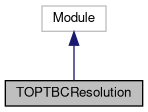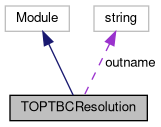 |
Belle II Software
release-08-01-10
|
 |
Belle II Software
release-08-01-10
|


Public Member Functions | |
| def | setOutputName (self, outputname) |
| def | setMaxWidth (self, maxWidth) |
| def | setMinWidth (self, minWidth) |
| def | setMaxAmp (self, maxAmp) |
| def | setMinAmp (self, minAmp) |
| def | ignoreNotCalibrated (self, ignoreNotCal) |
| def | event (self) |
| def | terminate (self) |
Public Attributes | |
| outname | |
| output name | |
| m_calpulseMaxWidth | |
| output name | |
| m_calpulseMinWidth | |
| output name | |
| m_calpulseMaxAmp | |
| output name | |
| m_calpulseMinAmp | |
| output name | |
| m_ignoreNotCalibrated | |
| output name | |
Static Public Attributes | |
| h_WidthVSAmplitude_1 | |
| Width VS amplitude, first calibration pulse. More... | |
| h_WidthVSAmplitude_2 | |
| Width VS amplitude, second calibration pulse. More... | |
| h_dVdtRising_1 = TH1F('dVdtRising_1', ' dV/dt of the TOPRawDigits (rising edge), first calibration pulse', 1000, 0, 1000) | |
| dV/dt on the rising edge, first calibration pulse | |
| h_dVdtRising_2 = TH1F('dVdtRising_2', ' dV/dt of the TOPRawDigits (rising edge), second calibration pulse', 1000, 0, 1000) | |
| dV/dt on the rising edge, second calibration pulse | |
| h_dVdtFalling_1 = TH1F('dVdtFalling_1', ' dV/dt of the TOPRawDigits (falling edge), first calibration pulse', 1000, 0, 1000) | |
| dV/dt on the falling edge, first calibration pulse | |
| h_dVdtFalling_2 = TH1F('dVdtFalling_2', ' dV/dt of the TOPRawDigits (falling edge), second calibration pulse', 1000, 0, 1000) | |
| dV/dt on the falling edge, second calibration pulse | |
| h_dVdtRisingVSdVdtFalling_1 | |
| dV/dt on the rising edge VS dV/dt on the falling edge, first calibration pulse More... | |
| h_dVdtRisingVSdVdtFalling_2 | |
| dV/dt on the rising edge VS dV/dt on the falling edge, first calibration pulse More... | |
| h_dVdtRisingDifference | |
| Difference between the dV/dt of the first and the second calpulse, using the rising edges. More... | |
| h_dVdtFallingDifference | |
| Difference between the dV/dt of the first and the second calpulse, using the rising edges. More... | |
| h_DeltaT_RR = TH1F('DeltaT_RR', ' DeltaT bewteen the rising edges', 4000, 10, 30) | |
| DeltaT rising-rising. | |
| h_DeltaT_FF = TH1F('DeltaT_FF', ' DeltaT bewteen the falling edges', 4000, 10, 30) | |
| DeltaT falling-falling. | |
| h_DeltaT_FR = TH1F('DeltaT_FR', ' DeltaT bewteen falling and rising edges', 4000, 10, 30) | |
| DeltaT falling-rising. | |
| h_DeltaT_RF = TH1F('DeltaT_RF', ' DeltaT bewteen rising and falling edges', 4000, 10, 30) | |
| DeltaT rising-falling. | |
| h_DeltaTVSChannel_RR | |
| DeltaT rising-rising VS channel. More... | |
| h_DeltaTVSChannel_FF | |
| DeltaT falling-falling VS channel. More... | |
| h_DeltaTVSChannel_FR | |
| DeltaT falling-rising VS channel. More... | |
| h_DeltaTVSChannel_RF | |
| DeltaT rising-falling VS channel. More... | |
| h_DeltaTVSdVdt_RR | |
| DeltaT rising-rising VS average of dV/dt on the first and second pulse. More... | |
| h_DeltaTVSdVdt_FF | |
| DeltaT falling-falling VS average of dV/dt on the first and second pulse. More... | |
| h_ResolutionVSdVdt_FF = TGraphErrors() | |
| DeltaT resolution VS average of dV/dt (falling-falling) | |
| h_ResolutionVSdVdt_RR = TGraphErrors() | |
| DeltaT resolution VS average of dV/dt (rising-rising) | |
| string | outname = 'outStudyTBCResolution.root' |
| output root file | |
| int | m_calpulseMaxWidth = 3. |
| maximum width to flag a calpulse candidate | |
| float | m_calpulseMinWidth = 0.5 |
| minimum width to flag a calpulse candidate | |
| int | m_calpulseMaxAmp = 700. |
| minimum amplitude to flag a calpulse candidate | |
| int | m_calpulseMinAmp = 250. |
| minimum amplitude to flag a calpulse candidate | |
| bool | m_ignoreNotCalibrated = True |
| ignores the hits wthout calibration | |
Module to study resolution and performances of the TOP Time Base Calibration.
Definition at line 27 of file studyTBCResolution.py.
| def event | ( | self | ) |
| def ignoreNotCalibrated | ( | self, | |
| ignoreNotCal | |||
| ) |
Sets the flag to ingore the hits without calibration
Definition at line 150 of file studyTBCResolution.py.
| def setMaxAmp | ( | self, | |
| maxAmp | |||
| ) |
Sets the maximum calpulse amplitude
Definition at line 140 of file studyTBCResolution.py.
| def setMaxWidth | ( | self, | |
| maxWidth | |||
| ) |
Sets the maximum calpulse width
Definition at line 130 of file studyTBCResolution.py.
| def setMinAmp | ( | self, | |
| minAmp | |||
| ) |
Sets the minimum calpulse amplitude
Definition at line 145 of file studyTBCResolution.py.
| def setMinWidth | ( | self, | |
| minWidth | |||
| ) |
Sets the minimum calpulse width
Definition at line 135 of file studyTBCResolution.py.
| def setOutputName | ( | self, | |
| outputname | |||
| ) |
Sets the output file name
Definition at line 125 of file studyTBCResolution.py.
| def terminate | ( | self | ) |
Write histograms to file, fills and fits the resolution plots
Definition at line 227 of file studyTBCResolution.py.
|
static |
DeltaT falling-falling VS channel.
Definition at line 82 of file studyTBCResolution.py.
|
static |
DeltaT falling-rising VS channel.
Definition at line 87 of file studyTBCResolution.py.
|
static |
DeltaT rising-falling VS channel.
Definition at line 92 of file studyTBCResolution.py.
|
static |
DeltaT rising-rising VS channel.
Definition at line 77 of file studyTBCResolution.py.
|
static |
DeltaT falling-falling VS average of dV/dt on the first and second pulse.
Definition at line 102 of file studyTBCResolution.py.
|
static |
DeltaT rising-rising VS average of dV/dt on the first and second pulse.
Definition at line 97 of file studyTBCResolution.py.
|
static |
Difference between the dV/dt of the first and the second calpulse, using the rising edges.
Definition at line 64 of file studyTBCResolution.py.
|
static |
Difference between the dV/dt of the first and the second calpulse, using the rising edges.
Definition at line 61 of file studyTBCResolution.py.
|
static |
dV/dt on the rising edge VS dV/dt on the falling edge, first calibration pulse
Definition at line 51 of file studyTBCResolution.py.
|
static |
dV/dt on the rising edge VS dV/dt on the falling edge, first calibration pulse
Definition at line 56 of file studyTBCResolution.py.
|
static |
Width VS amplitude, first calibration pulse.
Definition at line 32 of file studyTBCResolution.py.
|
static |
Width VS amplitude, second calibration pulse.
Definition at line 37 of file studyTBCResolution.py.